David’s Advice
Monday, February 20th, 2006If your decks are dry in the morning, cock your head northward and start looking for some wind. Wet decks mean just another typical day in the sea. (This from David of Puerto Escondido.)
If your decks are dry in the morning, cock your head northward and start looking for some wind. Wet decks mean just another typical day in the sea. (This from David of Puerto Escondido.)
We got back to La Paz Saturday night, took some excellent showers, abused our flush toilet privileges, and went out for tacos and refrigerated beer. The next day was Sunday and we spent the morning listening to Bill’s Net and then headed out for more tacos and various boat supplies. Bill has a half-hour or so discussion net every day on channel 21 starting around 7:30am. He usually lists off some headlines culled from various internet searches and the BBC, comments on them, and then invites whoever is listening to come ahead with their own comments. Pepe is the first to comment every day. “Pepe go.â€
Today was a slow news day, or else Bill missed this morning’s BBC news. “So anyone try out that stuff, ‘tor… er, tongue-fu’? Supposed to be some sort of soy curd. You eat it. Anyone know anything about this stuff?â€
… Silence …
Someone speaks up finally, “Do you mean … tofu?â€
Mind you, the discussion was previously all about Cheney and how there were women with Cheney and the shot guy (makes you feel like you’ve been out of town when you come back to discover that Cheney shot some dude in the face and nobody seems too concerned) and how they were not the wives of the men and just who were these women anyway. Then Clinton. The tofu thread was a short-lived one but actually enticed some of the boat women to comment. We’re back to typical topic matter with the Patriot Act now and the boat men have taken over once again.
Yesterday while loading some gasoline cans into the dinghy, this guy came over and started talking to us. We chatted about the Port-a-bote, then where he lived previously—he had lived in Maui for several years and then San Francisco—and if he knew this person or that person. Then we get to talking about where in San Francisco he lived, and he mentioned the Boat Club, which was just up the street from where we used to live, and we said something like, “Oh! We know a guy from the Boat Club!â€
“Really? Hey who do you know?â€
“This guy named Joe Cool.â€
“Really. [pause] How do you know Joe Cool?†Each word carefully measured.
“We met him on this guy Mark’s boat and blah blah blah†Chat chat chatterson…
“Um. I’m Joe Cool!†And clearly do not remember you.
He looked very different from the last time we saw him. But he remembered Mark and Mark’s boat and it all came back and he filmed us a bit with his camera to make sure he would remember us for next time. We decided to meet up with him in Tenerife when we get there, or at least look up his buddy at the kiteboard shop. This is the third person we’ve met along the way connected with the marina at Rio Vista where we bought Time Machine.
Anyway, we plan to hang around town for just a day or two, stock up on food and fuel, and then if the weather looks good, head across the Sea of Cortez to Mazatlan. It’ll be a while before we get back to La Paz and so the remainder of time not spent scouring town for supplies will surely be spent stuffing ourselves silly at all our favorite street food stalls.
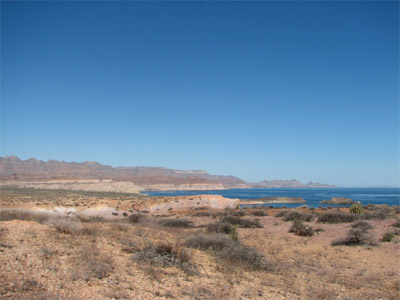
La Paz’s tractor beam is sucking us back down the coast to its bouncy anchorage on the pretext of obtaining a part for our busted traveler. Will we ever escape and get someplace warm?
Now that we have a SSB receiver radio, we get to listen to Don From Summer Passage, also known as Don The Weather Guy. Every cruiser in this area knows about Don but we just ‘met’ him, so to speak. He broadcasts from Oxnard at least twice daily on various SSB channels and gives a very perky rundown of the weather in all the key areas. “Gulf of Tuehuantepec? Will be screamin’. That’s right, 60 to 70-knot winds!! [Perk perk!] Pretty nasty stuff and you don’t want to be out in that. Not a bit! Seas 20-25 feet too; that’s as high as I’ve ever seen it! So any of you think you are going to make the crossing in that, well, you can just tell me how it was in the Afterlife! Ha!†Luckily the southern Sea only had a predicted 20+ norther and we took off south with ambitious destinations. We made it almost to Agua Verde and the wind died. Bleah. Motored in and anchored just as it began to pick up again. We hung out and attempted to take off the next day (the ‘peak’ day, according to weather reports) but didn’t even get out of the bay, the winds were so light. I couldn’t see any whitecaps anywhere with the binocs and another boat that had left ahead of us was still visible on the horizon, sails luffing in the nonexistent wind and big leftover swell. We returned to anchor and did boat projects. The next day we tried again and had good wind nearly to our next destination, when it again died completely, leaving us to motor into the anchorage at Gatos.
Again we had a good time at Gatos. Maybe the most spectacular land scenery we’ve seen at any anchorage anywhere. We hiked for several hours in the other direction this time. The mountains are layered with many different colors of dirt/rock and so when you hike around, you go through all these different colored areas. It’s just a really cool place.
Manuel the fisherman intercepted us as we attempted to leave Gatos for points south but there was no wind and no sea and we were just sitting out in the glassy water. He motored up and sat on our ama chatting with us for a bit holding onto his panga by a light leash. We told him we’d likely be pulling up to the beach at Timbabichi (a mere two miles south of Gatos) unless the wind performed a miracle and began to blow and he said if we did, he’d stop by later with some fish for us. Sweet!
A few hours later, anchored in Timbabichi, Manuel arrived with the goods: ‘chocolates.’ (What the?) They are large brown shiny clams and we traded some pesos for 20 of them. We asked Manuel how to cook them and he said you just boil them or whatever, like normal clams, which is what we did. They were great, not sandy at all; maybe a little on the large side if there were any complaints. Later, we ran into a couple in La Paz who were traveling around Baja with a camper and a folding kayak and the guy said that the best way to eat them was to take a large thin knife and split them right down the middle (uncooked, alive), then eat them like oysters on the half shell with lime juice and hot sauce. We told him that we boiled them with garlic butter and he went into fits. “AAHHHH!!! You ruined them! You ruined them!!†And his wife kept saying, “You didn’t ruin them, they are good no matter how you prepare them. Jeez!â€
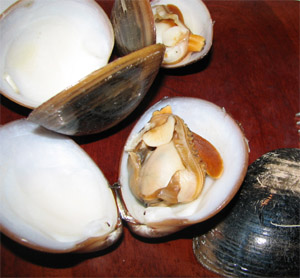
Chocolates! Boiled, not raw.
The next day we had light wind and crept south towards San Evaristo. Then the wind picked up insanely and we made wicked time. We pulled a bit of a Punta Baja when rounding the corner into the anchorage; winds that run over land intensify to insane proportions and generally anchorages are windier than the outside. Just another way life is not fair.
The next day we hopped over to Ensenada Grande on Isla Partida for the evening, chatted with a kayak guide from La Paz who was camped on the beach and returned to our boat to find that we had dragged anchor!! Ooop. It DID seem farther paddling back… We reset the anchor (it had reset itself but now were not in the position we wanted to be in) again and it held fine. We are not sure what caused it to drag; maybe it slid on some grasses? Hooked on the edge of a rock? Pretty embarrassing; I wonder if any of the other boats noticed. (“And they allll moved away from me on the bench…â€)
We arrived in La Paz once again in the evening and stuck our anchor down right smack in the middle of the channel. “Hey, here’s a great wide open space where nobody’s anchored! Score!!†We discreetly moved the next morning when we realized where we were and again wondered if anyone noticed.
Don’s weather report was for northers and good sustained winds in the 20-25 knot range, “right down the middle!†so we did our restocking as fast as we could and headed out to cross the Sea of Cortez two days later.
Puerto Escondido is the one of the ‘hurricane holes’ on the Sea of Cortez. It has a mile-long lagoon with a teeny tiny opening of maybe 50 meters. The immediate land area seems to have been under construction for ages but nothing has really come of it yet. So there is an empty neighborhood grid of streets and sidewalks with lampposts at every 200 meters or so but the streets are growing weeds through all the cracks and there are no actual buildings anywhere. A concrete boat launch ramp is just outside entrance of the lagoon with a sunken sailboat next to it, then a circular anchoring area with a concrete wall around it. There is a place where larger vessels can tie up and a couple of official-ish looking buildings surrounded by fences saying “Prohibito el Paso.†Supposedly there was free water for anyone who wanted it but when we found the spigot a day later, it was locked up. Directly outside of the lagoon entrance and concrete circular area/launch ramp is a very deep natural anchorage called the “Waiting Room†where boats were supposed to hang out waiting for favorable conditions to enter the lagoon (tides, crowding, etc.); however, this anchorage was absolutely full of boats, and the lagoon had hardly any. We motored directly into the lagoon to check things out and discovered the entire thing was a field of mooring balls—at least 100 of them. There were maybe 25 boats (tops) inside and most of them looked unoccupied. We were tweaked out by the place and wanted to anchor outside near the entrance, but there was just no space; we ended up having to anchor in the lagoon. We went ashore that evening to find the supposed water and garbage and walked around for a long time finding nobody and nothing that looked like water or garbage.
The next day before dawn, we headed out for Loreto, 15 miles to the north. We had zero wind and motored the entire way for crying out loud. We arrived in Loreto around 9:30 and anchored off the beach (there is absolutely no protection here so you have to keep an eye out for wind). We ate some awesome fish tacos, took some photos of the old cathedral, bought some veggies (limes were getting low! Ack scurvy!!!), and got some potable water for our jug. By the time we got back to the boat at noon, there were big fat whitecaps and some sprightly chop. I got soaked in the kayak back to the boat (all of 100 meters). I decided my outfit was ruined and we would not be going back to town for another load of water and fuel (we were down approximately five gallons from all the motoring we had done the previous couple of weeks) and headed back to Escondido.
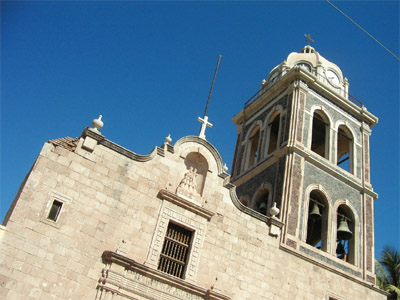
(Old quaint mission at Loreto.)
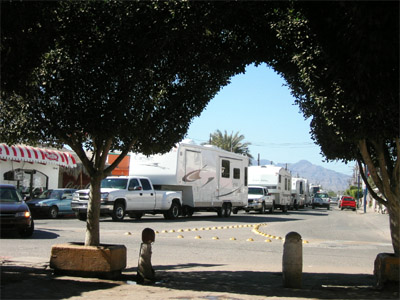
(Invasion of the Good Sams!)
Back in Escondido, again anchored in the lagoon, we at last found a guy named David to give us the scoop; he had lived there for the past 25 years.
“Man, I’ve been here for 25 years. This place used to be just a beach [gesturing at the concrete circular retaining wall where he was anchored, directly outside of the lagoon] and we’d just pull our dinghies up on the beach with whatever fish we caught that day. There was a Mexican family who lived on the beach and the woman would take your fish and for like a dollar, clean it and cook it for you. She could cook a fish too! We’d just hang out with them on the beach eating fish and drinking beer and watching the day grow dark. There’s no beach here anymore, obviously. You see they have this law in Mexico says that all playas are public property; so they built this wall here and presto! Now it’s not a playa anymore. Those of us who’ve been here so long built that dinghy dock so we could actually get to shore. You see they’ve been doing construction for a long time here; I don’t know what they think they’re going to do with it. They put those curbs and sidewalks in last year for that whole grid of streets; there’s no wiring or plumbing or anything underneath them though. All those lampposts? These guys come and paint them green every so often. Then they steal the bulbs out of them; take ‘em back to Loreto. Not that there’s any electricity for them anyway. Gotta love ‘em! So a private company took control of the place here recently and kicked all of us out of the lagoon; now they think they are going to charge $1 per foot per day to anchor there! What a joke. That’s why the Waiting Room and this place are so crowded. They put in all those mooring balls to rent out; I saw them make them—the concrete bottom’s fine, but they embedded polypropylene rope and not chain to the mooring ball [and ultimately the boat tied to it]. That stuff chafes so badly—that’s what happened to that boat over there [pointing at the sunken boat by the launch ramp]. In fact, those mooring balls come loose periodically even without boats pulling on them; there’s one floating around right inside the entrance there. And that construction there? [Some vague building scaffolding and concrete nearby with a bunch of workers milling around.] That’s supposed to be finished in April! Hah! And that Pemex station? [Right next to the scaffolding.] They are expecting boats to Med-moor up to the gas station while they pump the gas. This all exposed to the north! What a sight that would be during a norther.â€
It was depressing listening to how much things had gone downhill since the good ol’ days but David was pretty damned cheerful about it all. “The cruiser’s net in the mornings. We cruisers started that way back when; ‘course now most of them are radioing in from land. Funny how they give up the boating life, move onto the land and think they own something.†It was fun talking to him and he had many good stories to tell. He said that the La Paz Cruiser’s Club was started after too many cruisers began making a habit of hanging out on the beach across from Hotel Los Arcos drinking beer with the local guy who kept watch over the dinghies (they would bring him things from town, like beer, to thank him, then help him drink it). Well, more than ten drunk gringos on the beach equals An Unlawful Gathering, which was a threat to the State of Mexico in the ‘80s, and something had to be done. Luckily Hotel Los Arcos opened their doors and said they would be happy sell the gringo cruisers as much beer as they could drink any day of the week. So this became the new hangout and thus was born the Club Cruceros.
He told us where we could get water that wasn’t locked. “Shit! We’re the ones who put that water in; that private company came and locked it up. There are nine freshwater wells at the foot of those mountains…â€
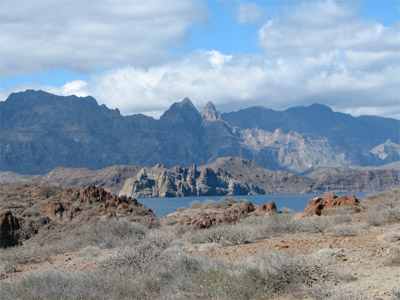
(These mountains.)
“We have the best water around too. People from Loreto used to come here to get water! Too many people shitting upstream of the water in Loreto. Nobody shitting upstream of our water here!â€
Another norther was coming through, according to the morning weather net, and we hoped to ride it back to La Paz. We awoke to dry decks, pulled anchor, and escaped Puerto Escondido before They wised up to us anchoring (and not paying) in their $1/foot/day harbor.
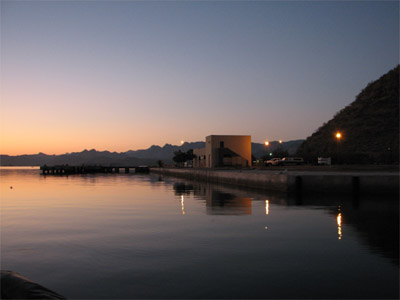
(Escape from Puerto Escondido at dawn.)
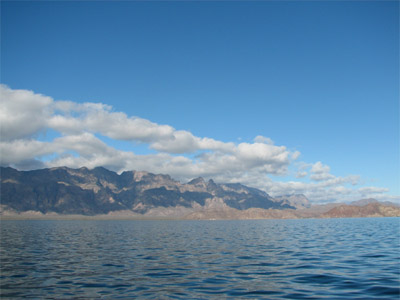
A couple of days later, another south breeze cropped up and we headed out towards Puerto Escondido. After an hour of some perky sailing, the wind pretty much crapped out. We bobbed around for a bit, hauling different sails trying to move in some direction that could vaguely be construed as “forward,†and finally put the motor in the water. Funny thing about most of our short day passages: we take off in brisk wind, make excellent time, “Hey! If this keeps up, we should be to Puerto Anclaje in three hours; maybe we can even make it to Puerto Proximo Anclaje today.†Then the wind starts to shift and/or falter, “Hrmmm, should we put up the 170?†(The GPS estimates our travel time at three hours.) Then the wind dies, yet frothy whitecaps are plainly visible all around us; where we are located is a syrupy bath of shimmering non-windy shininess, “Looks like we should have some wind in a sec; maybe hold off putting up that gennaker.†No wind ever reaches us. The GPS estimates our arrival time at Puerto Anclaje in 38569306 hours. “Well, give it a minute, maybe it’s just changing direction.†It’s not changing direction. “Crap!†We probably have to motor if we want to get anywhere; “Should we put in the motor?†We are very non-committal on the motor issue. “If you want to.†It’s plainly obvious that we will not make it the 7 knots to our anchorage in less than 4402 years, let alone nightfall. “Oh I’LL start the dang motor!†Naturally, the moment we round the corner into our anchorage and get ready to drop the hook, the wind starts howling at 20+ knots.
Anyway, this was how the next couple of days of “sailing†went. We finally made it to Candelero Chico, a north-facing anchorage (we had a south “wind†so it seemed pretty mellow). And of course big fat gusts of southern wind came blasting around the hills and assaulted our little boat the moment we entered the tiny cove. Not the most restful night ever, but the anchorage was very cozy and there was a herd of cows that came ambling down the cliffside, mooing and ringing their neck-bells. (Cow question number one: Do they notice the persistent clanging sound, and if so, are they aware that it is coming from their very own necks?) Those cows came to the water’s edge (that’s SEAwater, by the way) and then they DRANK FROM IT. At least the first couple of cows did. Then they all stood in a crowd facing the water and stared at it for maybe 30 minutes, after which time they all turned around, faced the opposite direction, and stood gazing off for another hour or until after dark when we couldn’t see them anymore.

The next morning, the wind was perky as usual and we headed out northward towards Escondido or Danzante Island, or hell, Carmen if the wind keeps up! Wind did not keep up, and we ended up finally breaking down and motoring into Danzante’s “Honeymoon Cove†(that’s not Spanish, obviously, but that’s what our book says) a little after lunch. We wandered all over Danzante’s northern end and took lots of pretty pictures.
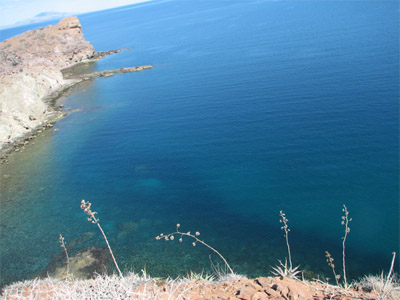

Pretty! Pretty! Pretty!
Later that afternoon, another southern wind (the anchorage was protected from the north only) perked up, making the anchorage uncomfortable, so we pulled anchor and headed for a spot about nine miles north. Again, the wind was totally perky for a mile or two, then faded and totally died right at our immediate location (whitecaps all around, as usual, sigh, yawn, swear). We turned around and headed back for Puerto Escondido to anchor for the evening.